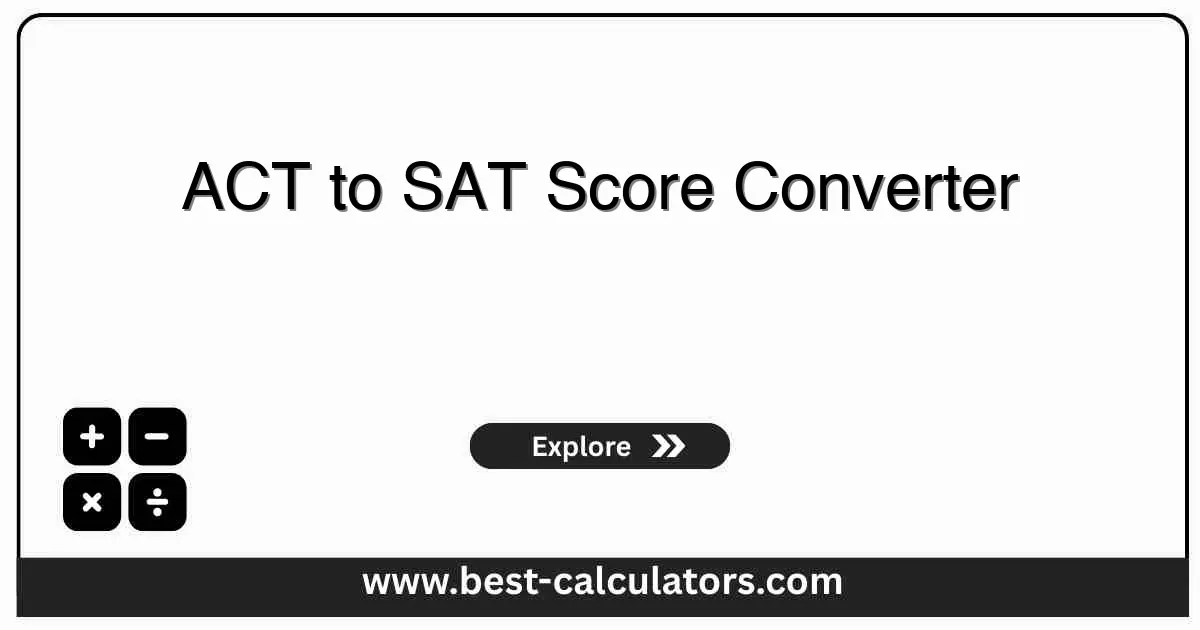ACT to SAT Score Converter - Estimate Your SAT Equivalent
Convert your ACT composite score into an estimated SAT-equivalent score using concordance-style mappings for smarter admissions planning.
ACT to SAT Score Converter
SAT Equivalent Results
Conversions are based on concordance-style mappings anchored to official data, kept monotonic and realistic. Always verify with the latest College Board/ACT concordance tables and individual college policies.
What is an ACT to SAT Score Converter?
An ACT to SAT Score Converter is a specialized academic tool that translates your ACT composite score into an estimated SAT-equivalent total score using concordance-based mappings. It helps you compare results, choose which score to send, and understand where you stand in a unified scale.
Instead of guessing or misreading charts, this converter gives a clear, monotonic mapping aligned with official concordance principles so that higher ACT scores always correspond to higher SAT equivalents.
This calculator is especially useful for:
- College admissions planning - Decide whether ACT or SAT looks stronger.
- Scholarship evaluation - Compare eligibility cutoffs stated in SAT terms.
- Test strategy - Set realistic score goals if switching between ACT and SAT.
To evaluate your raw ACT performance before conversion, use our ACT Score Calculator to verify your composite score and understand each section’s contribution.
To analyze how your SAT scores compare directly by percentile, explore our SAT Score to Percentile Calculator to see where your SAT-equivalent stands nationally.
To understand how standardized test strength aligns with GPA, use our High School GPA Calculator to ensure your transcript supports your converted score.
For planning scholarships that consider both ACT/SAT and GPA, try our Scholarship Eligibility Calculator to estimate merit and need-based opportunities.
To assess long-term value of your target colleges once your scores are competitive, check our Graduate School ROI Calculator and related tools to align academics with return on investment.
How the ACT to SAT Converter Works
The converter uses a piecewise monotonic mapping modeled on official ACT/SAT concordance tables and well-documented relationships between ACT composite and SAT total scores.
Key logic principles:
- Monotonic mapping – Higher ACT scores always map to higher SAT-equivalent scores.
- Concordance-based anchors – Uses realistic anchor pairs (e.g., 21 ≈ 1060, 24 ≈ 1160, 28 ≈ 1310, 30 ≈ 1360–1370, 32 ≈ 1420, 34 ≈ 1490, 36 ≈ 1590–1600).
- Range + midpoint – For each ACT score, the tool reports an estimated SAT range and a midpoint for clarity.
- Validation-first – Inputs are clamped to valid ACT ranges; impossible values are corrected with an explanation.
Key Concepts: Concordance and Comparability
Score Concordance
Concordance tables provide statistically derived relationships between ACT and SAT scores so colleges can interpret results on a common scale.
Equivalent, Not Identical
An equivalent score indicates similar standing in the test-taking population, not identical content or question difficulty.
How to Use This Calculator
Enter ACT Composite
Input your official ACT composite score between 11 and 36.
Add Sections (Optional)
Optionally enter your lowest and highest section scores for context.
Review SAT Equivalent
See the estimated SAT range and midpoint instantly in the results panel.
Plan Strategy
Use the conversion to choose which test score to send and set score goals.
Benefits of Using This Converter
- • Clarity: Understand how your ACT result translates into SAT terms without manual chart lookup.
- • Admissions Strategy: Decide if sending ACT or SAT will better represent your performance.
- • Scholarship Targeting: Compare score-based awards that publish SAT cutoffs.
- • Goal Setting: Set realistic improvement goals if retaking either exam.
Factors That Affect Interpretation
1. Concordance Updates
Official concordance tables can be updated. Use this tool as guidance and confirm against the latest official releases when precision is critical.
2. Institutional Policies
Colleges may prioritize one test, superscore, or treat ranges differently. Always check each institution’s score-use policy.
3. Test-Optional Trends
With growing test-optional policies, strong scores help but are part of a broader review including GPA, rigor, essays, and activities.

Frequently Asked Questions (FAQ)
Q: How does the ACT to SAT score converter work?
A: It uses concordance-style mappings modeled on official joint College Board and ACT data, assigning each ACT composite a realistic SAT-equivalent range and midpoint.
Q: Are these conversions official?
A: No. They are high-quality estimates aligned with historical concordance tables. For formal reporting or cutoffs, always rely on the latest official concordance charts.
Q: What ACT score is competitive in SAT terms?
A: Roughly, ACT 24 (≈1160 SAT) is solid, 28 (≈1310 SAT) is strong, 31–32 (≈1390–1420 SAT) is highly competitive, and 34–36 (≈1490–1600 SAT) is elite.
Q: Can I use this to decide which score to send?
A: Yes. Convert your ACT to SAT-equivalent and compare with any real SAT score you have. Submit whichever appears stronger relative to your target colleges’ ranges.
Q: Does this tool account for superscoring?
A: No. It works from a single official ACT composite. Colleges that superscore may evaluate results differently from a simple one-to-one concordance.
Q: Is a higher converted SAT always better?
A: A higher equivalent suggests stronger performance, but colleges review your full profile: GPA, rigor, essays, recommendations, and context remain critical.